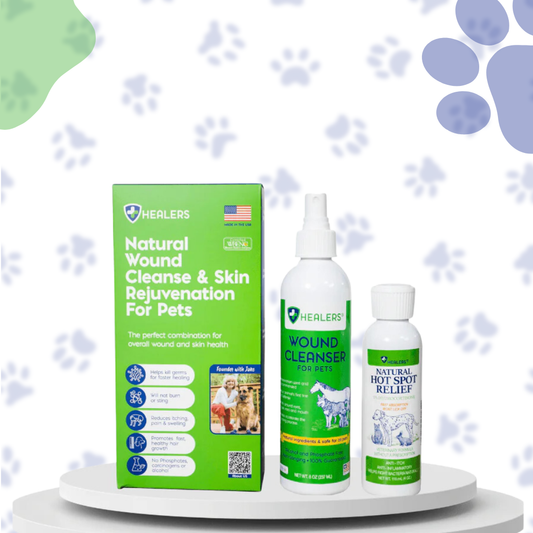Understanding Your Dogs’ Seasonal Allergies
Share
Transitioning between seasons means more than simply putting out different decorations or planning for holidays. It also brings a change in temperatures and weather patterns, both of which unleash a new wave of allergens that impact humans and pets alike.
Many dog breeds are highly susceptible to environmental and seasonal allergens. Symptoms can manifest in many ways, only some of which are obvious. This guide will help you recognize dogs’ allergies and provide a crash course on treatments.
How to Recognize Seasonal Allergies in Dogs :
Seasonal allergies typically occur in response to grasses, molds, pollen, ragweed, and trees. They show up in many ways, but here are a few of the most common:
Ear problems — Some dogs’ ear canals become itchy or inflamed during the allergic response. Check your dog’s ears for redness or a buildup of brownish-colored gunk. These are indications that the ears are becoming irritated, inflamed, or possibly infected.
Hot spots — Hot spots form when inflamed skin is infected by your dog’s natural bacteria that has kicked into overdrive. They are very red spots with bleeding or scabbing and can involve oozing, inflammation and hair loss.
Inflammation and itchiness — Swollen, red, and slightly raised patches of skin that are tender to touch or may itch. If you notice your dog scratching more than usual or rubbing his or her face or sides on coarse-grained materials like carpets, he or she likely has itchy or inflamed skin.
Redness — Just as people develop redness around their noses or eyes when they suffer allergies, dogs can get red eyes, mouths, or paws, and even show redness around their anuses.
Respiratory issues — Though less common in pets than in people, your dog might develop coughing, runny nose, sneezing, or watery eyes.
How to Treat Seasonal Allergies :
Allergies are tough for people, but humans can make their own efforts to fix the problem. Pets rely on you for that relief, and there are plenty of medicinal and holistic remedies available to help alleviate their discomfort.
Baths and soaks — Tea Tree Oil Conditioning Shampoo for Pets -Tea Tree Oil Conditioning Shampoo leaves your pet’s coat silky, shiny, rejuvenated and clean. Unlike many commercial products, our pet shampoo does not leave a film on the pet’s coat because it is not petroleum based. Tea tree oil is anti-microbial, has insect-repelling qualities, minimizes flaking and dandruff, and leaves the coat and skin rejuvenated and clean. Peppermint oil gives the shampoo a pleasant scent, and Healers Tea Tree Conditioning Shampoo for Pets comes in a concentrated form, making it an economical option for pet owners
Coconut oil — One or two tablespoons can be melted and poured over your dog’s food when he or she eats. It can work on dogs’ skin conditions from the inside out, as it has qualities that benefit healthy coat and skin and help regulate bacteria levels.
Diet — An anti-inflammatory diet focuses on protein and minimizes carbohydrates. Purchase food that has low grain content to boost your pup’s system.
Ear rinses — These can be found in pet and grocery stores or can be made by diluting apple cider vinegar in water (1:4). Squirt a small amount in your dog’s ear, massage into the ear canal, then wipe dry with a cotton square to remove excess moisture and clean out harmful yeast &/or bacteria.
Sprays — Healers Cut and Wound Spray For Pets & Hot Spot Relief Aid --
are great for alleviating the sting and inflammation in hot spots and other wounds. Both work great with Healers bandages to keep afflicted areas clean.
Use dog booties — Dog’s paws often get itchy from allergies, and they can’t help but lick them to relieve the discomfort. Using Healers medical wraps to cover the affected areas may prevent excess licking and further irritation, and allows the medicine to stay on paws and begin doing its job.
Vacuum often — This helps remove dust and environmental allergens that might be contributing to your pup’s seasonal allergy response. Wash his or her bedding regularly, too, to keep sleeping areas free from such elements, too.
Wrap the areas — Healers bandages come in body, leg, and paw varieties to help with allergies and other dog body wounds. Apply creams and sprays to the impacted areas, then use these bandages to keep the medicine in place and possible contaminants out.
If You Have Questions, Ask Them
If you have questions or concerns about your dog’s allergies, give your vet a call. Most importantly, if your dog is also experiencing excessive fatigue, bleeding, or lack of appetite, or exhibiting other not-normal behaviors, call a vet immediately. The most important thing is a healthy, happy pet!





